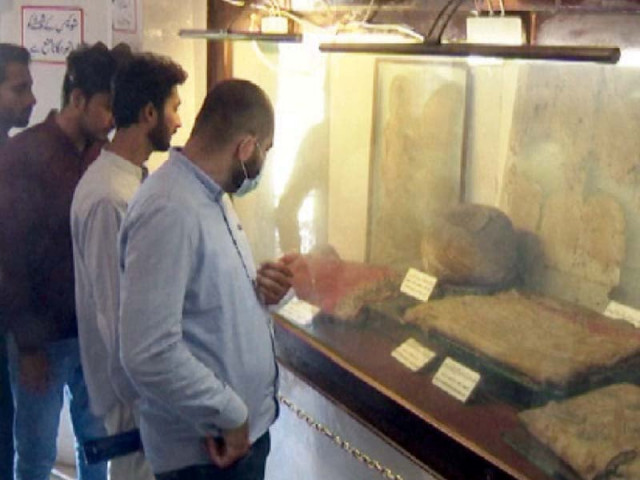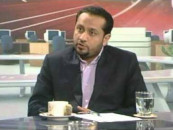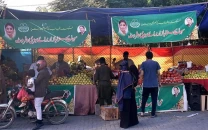House of Islamic relics to be renovated
A team of Turkish experts has already inspected Lahore’s Tabarukat Gallery for redecoration

The Punjab Chief Minister has released special funds for the upgradation of the Tabarukat Gallery located within the historic Badshahi Mosque in the walled city of Lahore.
The museum, which features a collection of ancient artefacts related to Prophet Muhammad (PBUH) and his family as well as rare copies of the Holy Quran penned in gold and silver, is visited by Muslims from around the world.
Out of the 27 artefacts preserved here, 10 are attributed directly to the last Messenger of Islam (PBUH), as items said to be of his personal use. These include the Holy Prophet’s (PBUH) turban, his cap, a pair of his shoes, his robe, an imprint of foot, the Islamic flag, a prayer mat, his daughter Fatima’s (RA) handkerchief, the sipara of Hazrat Ali, the turbans of Imam Hussain and Ghaus-ul-Azam, a fragment of Uwais al-Qarni’s tooth and several other artefacts held sacred to Islamic history.
Speaking to The Express Tribune, Badshahi Mosuqe Khatib Maulana Syed Abdul Khabir Azad said that the Tabarukat Gallery remains open to all and sundry, without any ticketing system. “Visitors and patrons of the gallery however gladly donate millions of rupees through the donation boxes placed by the endowment department. These generous offerings collected from the gallery also make for a major source of income for endowments.”
Narrating an incident of theft, the Khatib said that a part of Holy Prophet’s (PBUH) sandal was stolen from the gallery almost 18 years ago. “In 2014, the endowment department had announced Rs two million in reward for anyone who recovers the stolen article, but six years later the item still remains missing,” revealed Azad.
Relic journey: From Arabia to Pakistan
Talking about the journey of these rare Islamic artefacts from the sandy vastness of seventh century Arabian Peninsula to a Mughal-era establishment in present-day Pakistan, the Khatib said some of them were first presented to Amir Timur when he conquered Damascus in 1401. The remaining came into the Turco-Mongol conqueror’s possession when he took over Rome in 1402. Timur took all the artefacts with him to Samarkand, where after his death they came into the possession of his descendants.
When Babar conquered India and laid foundation of the Mughal Empire, he is said to have brought these artefacts with him to the Indian subcontinent. According to local archeologist Afzal Khan, when the queen of Nasir-ud-Din Muhammad Shah was in dire straits, she is said to have sold these artefacts to Pir Muhammad and Shah Muhammad Raza, which they shared among themselves for a price of Rs 80,000.
Later, Pir Muhammad took his share of the artefacts with him to his hometown of Rasool Nagar. However, the region was soon attacked by Sikh Emperor Maharaja Ranjit Singh’s father Sardar Maha Singh, who eventually came into the possession of the ancient Islamic relics.
When the rumors of Shah Zaman Durrani’s invasion spread in 1769, Ranjit Singh is said to have handed over the artefacts to his queen Mehtab Kaur, along with other valuables which she in turn passed on to her mother Rani Sada Kaur for safekeeping.
Upon Durrani’s return to Kabul, Ranjit Singh demanded for all items to be returned to him. Although Sada Kaur agreed, she decided to keep the Islamic artefacts for herself. Following the queen mother’s death, the articles came into the possession of General Sher Singh, a member of the Sikh nobility. After him, the artifacts became property of the Khalsa government and were housed in the mansion of Sardar Hira Singh until finally being preserved at the Lahore Fort, along with other antiquities.
Later, during the British Raj, these artefacts were handed over to the Muslims and since then, all these antiquities have remained preserved at the Badshahi Mosque, Lahore.
Addressing recent developments at the gallery and the greater Badshahi Mosque, Maulana Syed Abdul Khabir Azad said that the provincial chief minister has allocated special funds for the gallery’s upgradation. “A Turkish team has already visited the Badshai Mosque and beautification work at the gallery is reported to be underway.”
Published in The Express Tribune, October 13th, 2020.



















COMMENTS
Comments are moderated and generally will be posted if they are on-topic and not abusive.
For more information, please see our Comments FAQ